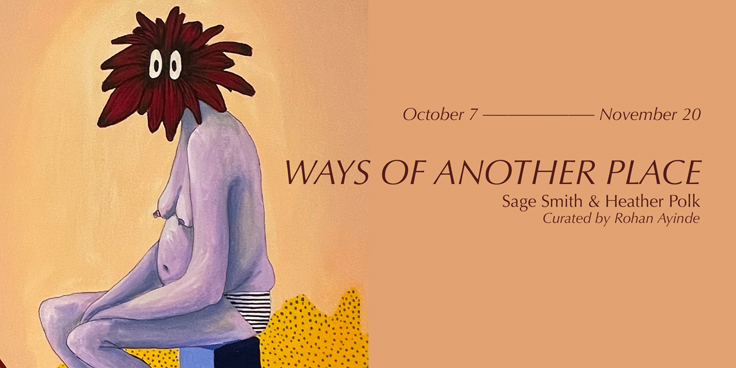“In Ways Of Another Place, we are invited to fall into worlds sculpted from the complex interior lives of Sage Smith and Heather Polk. Through the deep blacks of Heather Polk’s collages and the vivid playfulness of Sage Smith’s paintings, you are transported into a landscape of surfaces that ripple and flex with self-reflection. It is as if transported into Alice’s Wonderland with fragments of N.K. Jemisin’s Onyx Obelisk floating above it. This is a world in which you encounter your most challenging emotions as colorful and unnerving characters; smiles neither welcome nor menacing, but whose eyes follow you unblinkingly. It is also a world whose terrain refuses to stay still, moving beneath your feet in the same way memories shift and reconstitute themselves over time.
Between them, we lose ourselves in a space that walks between the abstract and the figurative; narrative and meaning are discovered in the wide and layered cracks that mark the shared vocabulary of their work. United by the visual language of collage, but working in distinctly different mediums (Heather in collage, Sage in painting), these two artists have sought to reflect on the possibilities their bodies harbor through exploring the fissures and multiplicities articulated when you layer texture, pattern, image, and form on top of, across and in conversation with one another. There are no stable locations. There are no certainties.
While Sage and Heather have arrived at these bodies of work from very different junctions in their lives, both pivot around similar concerns. Both have sought to look inward as a means to process difficult sets of emotions, their work becoming a tool to unpack and create movement out of potentially paralyzing situations. It is also interesting to make note of the adjacencies that have occurred in both women’s work. Sage has moved from painting abstract landscapes to creating defined and cogent characters that emerge from and sink into a concoction of patterns and color. Heather has pivoted from making colorful, figurative collages that explore and pay homage to Black life to crafting fractured, abstract scenes in kaleidoscopic shades of black. This counter-motion in the wider scope of their practices allows us to think about the many ways we might move inward. It gives us pause to realize that a journey of self-discovery and its resulting revelations looks and feels different for everyone, regardless of the outward identities they might share, but that “a piece of each Black woman remembers the old ways of another place – when we enjoyed each other in a sisterhood of work and play and power.” “
